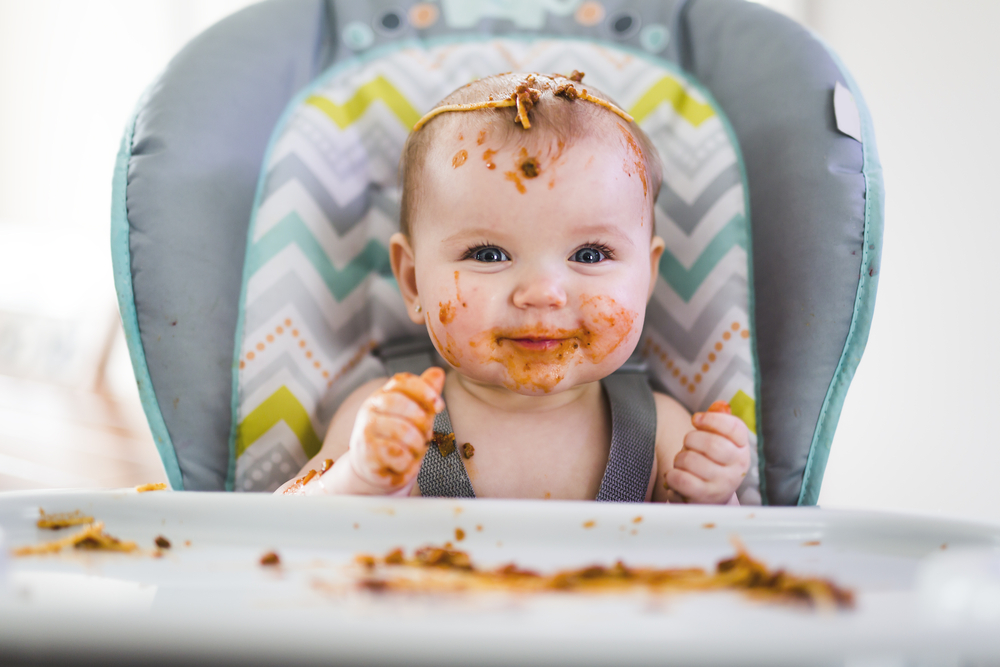Sometimes parents can feel worried about their baby choking and gagging when starting to eat solid foods. As your baby is learning to chew, swallow and experience new food textures, he may gag or in rare cases choke.
Here are some things you can do to keep your baby safe when starting solid foods:
- Wait until your baby is 6 months old and showing signs of readiness before starting solids.
- Feed your baby the textures he is ready for.
- Cut or cook foods to make them safer.
- Make sure your baby is sitting down. This helps him focus on eating. Never let your baby move, crawl or walk around while eating.
- Supervise your baby while he is eating.
- Consider taking Infant First Aid and CPR training so you can respond in an emergency.

Keep reading to learn the difference between gagging and choking and how to respond.
Gagging
Gagging is a normal part of learning how to eat and helps your baby avoid choking. Your baby may gag if food touches the back part of his mouth and triggers the gag reflex. Gagging brings the food to the front of the mouth so that your baby can chew it better. Some babies have a very sensitive gag reflex and gag often, especially when first learning to eat solids.
What to do if your baby gags
- Stay calm if your baby gags to help him stay calm too. If you panic, your baby might get upset and be scared of eating. If your baby is upset, pick him up and comfort him
- Once your baby stops gagging and swallows, see if he wants to keep eating. If he does, continue the meal as usual.
Choking
Babies and young children are at a higher risk for choking. This is because they:
- Have less practice eating
- Don’t have molars to grind up their food
- Have small airways
- Like to put things in their mouths
Foods and Choking
Food can be a choking hazard for babies and children under 4 years old. You can reduce their risk of choking by:
Not giving your young child these common choking hazards:
- Raisins
- Gum
- Marshmallows
- Gummies
- Hard candies or cough drops
- Popcorn
- Nuts and seeds
- Fish, meat or chicken with bones
- Snacks with toothpicks or skewers
- Hard round foods such as grapes, hot dogs or carrots.
Preparing your child’s food safely. See our page on What Food do I Give my Baby First?
Note: Other videos may be recommended by the host channel (e.g. YouTube, Vimeo). These suggestions may be based on your personal search history and other factors. The WRHA does not control these suggestions and is not responsible for and may not endorse the content.
What is the difference between partial choking and choking?
Partial choking is:
When the airway is partially blocked. Coughing is the body’s way of clearing the airway. A baby who is coughing is still able to breathe, which could indicate be a partial blockage of the airway. Encourage your child to keep coughing to help him clear his airway. Stay with him and watch him closely.
Choking is:
When your baby’s airway is fully blocked and she cannot breathe.
Signs of choking include:
- Baby may start making high-pitched noises, is wheezing, can no longer make a sound, or becomes too weak to cough
- Baby looks blue or discoloured (around the mouth)
- Baby may appear distressed or panicky
Choking is a medical emergency. Your baby needs medical attention right away.
What to do in case of choking
Call
- Shout for help to get a bystander or a family member to assist you.
- Have someone call 9-1-1. If you are in a public place ask someone to see if there is an AED (automated external defibrillator) while you care for the baby.
- If you are alone, immediately give care for complete choking (see below) and continue to shout for help.
Care


- Sit or kneel holding the baby.
- Position the baby face down along your forearm, holding his or her jaw in your hand.
- Rest your forearm on your leg so that the baby’s head is lower than his or her body.
- Deliver 5 firm back blows between the shoulder blades with the heel of your free hand.
- If the object has not come out, turn the baby face-up, while you support the head.
- Place 2 fingers on the middle of the baby’s chest just below the nipple line and quickly deliver 5 firm chest compressions, pushing down 1/3 of the chest’s depth.
- Repeat the 5 firm back blows and 5 chest compressions until the object is coughed up, the baby starts to cry, breathe, or cough, or until emergency help arrives.
Please note that these tips provided by the Red Cross Prevention and Safety team are for reference only and are not a substitute for first aid training.
*Reproduced with permission from the Canadian Red Cross.


